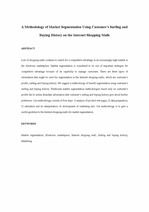

-
미리보기
소개
MS-Word로 작성한 자료입니다. 텍스트 파일과 그림 파일 둘을 zip으로 묶었습니다.목차
1. INTRODUCTION
2. MARKET SEGMENTATION AND ELECTRONIC MARKETS
2.1 Market Segmentation
2.2 Benefit Segmentation
2.3 Market Segmentation in the Electronic Marketplace
3. A METHODOLOGY OF BENEFIT SEGMENTATION
4. CONCLUSIONS본문내용
Lots of shopping malls continue to search for a competitive advantage in an increasingly tight market in the electronic marketplace. Market segmentation is considered to be one of important strategies for competitive advantage because of its capability to manage customers. There are three types of information that might be used for segmentation in the Internet shopping malls, which are customer’s profile, surfing and buying history. We suggest a methodology of benefit segmentation using customer’s surfing and buying history. Traditional market segmentation methodologies based only on customer’s profile fail to utilize abundant information that customer’s surfing and buying history give about his/her preference. Our methodology consists of four steps: 1) analysis of product web pages, 2) data preparation, 3) estimation and its interpretation, 4) development of marketing mix. Our methodology is to give a useful guideline to the Internet shopping malls for market segmentation.참고자료
· [1] T.Liang and J.Huang, “The empirical study on consumer acceptance of products in electronic markets: Transaction cost model,” Decision Support Systems, vol. 24, pp.29-43, 1998.
· [2] J.D.Wells, W.L.Fuerst, and J.Choobinceh, “Managing information technology (IT) for one to one customer interaction,” Information & Management, vol. 35, pp. 53-62, 1999.
· [3] Y.Wind, “Issues and advances in segmentation research,” Journal of Marketing Research, vol. 15, pp. 317-337, 1978.
· [4] P.Kotler and G. Armstrong, Principles of Marketing, 8th ed. Prentice Hall, 1998, pp.194-230.
· [5] R.Arunkundram and A.Sundararajan, “An economic analysis of electronic secondary markets: Installed base, technology, durability and frim profitability,” Decision Support Systems, vol. 24, pp. 3-16, 1998.
· [6] R.T.Moriarty and D.J.Reibenstein, “Benefit segmentation in industrial markets,” Journal of Business Research, vol. 14, pp.463-486, 1986.
· [7] M.Wedel, Jan-Benedict, and E.M.Steenkamp, “A clusterwise regression method for simultaneous fuzzy market structuring and benefit segmentation,” Journal of Marketing Research, pp. 385-396, Nov. 1991.
· [8] R.I.Haley, “Benefit segmentation: A decision-oriented research tool,” Journal of Marketing, vol. 32, pp. 30-35, Jul. 1968.
· [9] R.J.Calantone and A.G.Sawyer, “The stability of benefit segmentation,” Journal of Marketing Research, vol.15, pp.395-404, Aug. 1978.
· [10] W.Smith, “Product differentiation and market segmentation as alternative marketing strategies,” Journal of Marketing, vol. 21, pp. 3-8, Jul. 1956.
· [11] P.E.Green and W.S.Desarbo, “Componential segmentation in the analysis of consumer trade-offs,” Journal of Marketing, vol. 43, pp. 83-91, Fall 1979.
· [12] D.L.Hoffman and T.P.Novak, “Marketing in hypermedia computer-mediated environments: Conceptual foundations,” Journal of Marketing, vol. 60, pp. 50-68, Jul. 1996.
· [13] M.C.Angelides, “Implementing the internet for business: A global marketing opportunity,” International Journal of Information Management, vol. 17, no. 6, pp. 405-419, 1997.
· [14] P.E.Green and V.Srinivasan, “Conjoint analysis in consumer research: Issues and outlook,” Journal of Consumer Research, vol. 5, pp. 103-123, Sep. 1978.
· [15] W.Kamakura, “A least squares procedure for benefit segmentation with conjoint experiments,” Journal of Marketing Research, vol. 25, pp. 157-167, May 1998.
· [16] G.W.Kirkwood and R.K.Sarin, “Ranking with partial information: A method and an application,” Opera<font color=aaaaff>..</font>태그
-
자료후기
Ai 리뷰이 자료는 내용의 깊이가 뛰어나고, 주제에 대한 체계적인 접근이 인상적이었습니다. 과제를 작성하는데 많은 도움이 되었습니다. 여러분께도 추천합니다! -
자주묻는질문의 답변을 확인해 주세요

꼭 알아주세요
-
자료의 정보 및 내용의 진실성에 대하여 해피캠퍼스는 보증하지 않으며, 해당 정보 및 게시물 저작권과 기타 법적 책임은 자료 등록자에게 있습니다.
자료 및 게시물 내용의 불법적 이용, 무단 전재∙배포는 금지되어 있습니다.
저작권침해, 명예훼손 등 분쟁 요소 발견 시 고객센터의 저작권침해 신고센터를 이용해 주시기 바랍니다. -
해피캠퍼스는 구매자와 판매자 모두가 만족하는 서비스가 되도록 노력하고 있으며, 아래의 4가지 자료환불 조건을 꼭 확인해주시기 바랍니다.
파일오류 중복자료 저작권 없음 설명과 실제 내용 불일치 파일의 다운로드가 제대로 되지 않거나 파일형식에 맞는 프로그램으로 정상 작동하지 않는 경우 다른 자료와 70% 이상 내용이 일치하는 경우 (중복임을 확인할 수 있는 근거 필요함) 인터넷의 다른 사이트, 연구기관, 학교, 서적 등의 자료를 도용한 경우 자료의 설명과 실제 자료의 내용이 일치하지 않는 경우
문서 초안을 생성해주는 EasyAI

